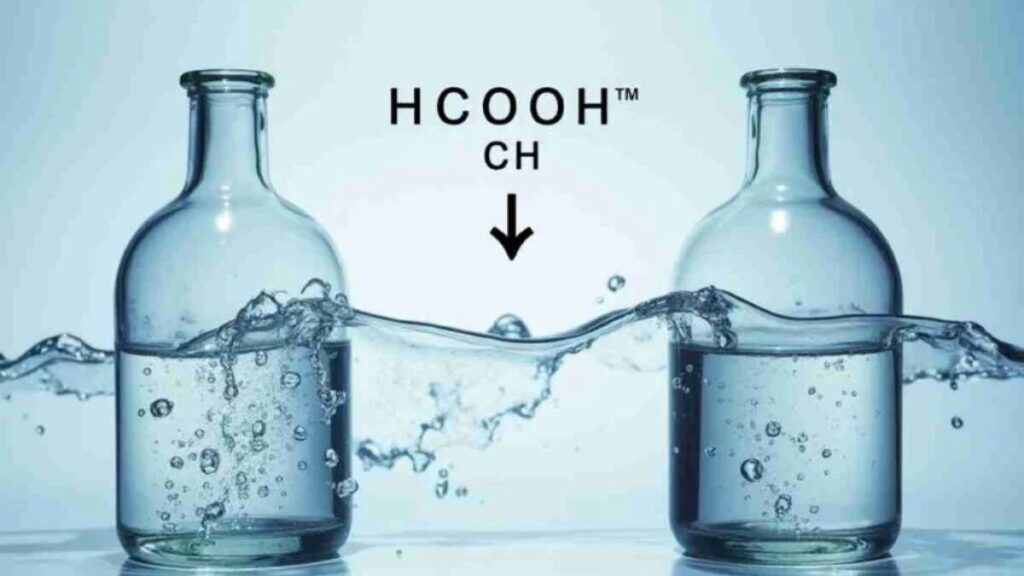From the tang of your morning coffee to the slick polish on your hardwood floors, chemistry wields a silent authority over our daily lives. Yet behind every transformative reaction and every miraculous material is a cluster of deceptively simple molecular formulas—one of which is “hcooch ch2 h2o.” Though it may look like gibberish to the uninitiated, this string of letters and numbers conceals an alchemy that fuels industries, underpins biological processes, and even shapes the modern world. Let’s embark on a journey into the heart of hcooch ch2 h2o, unpacking its secrets, tracing its history, and revealing how this unassuming formula orchestrates wonders all around us.
1. First Impressions: What Is “hcooch ch2 h2o”?
At face value, hcooch ch2 h2o appears to be two distinct fragments:
-
HCOOCH – A formate (HCOO–) linked to a methine group (–CH–), reminiscent of an ester or derivative of formic acid.
-
CH₂ – A simple methylene bridge, ubiquitous in organic structures.
-
H₂O – Plain old water.
But chemists know that these aren’t random pieces—they hint at a small but potent molecule family grounded in formic acid chemistry and hydrated intermediates. The grouping suggests something like a formate ester (HCOO– linked to a carbon) that exists in equilibrium with a hydrated aldehyde-like species in presence of water (H₂O).
In practical terms, hcooch ch2 h2o evokes molecules like methyl formate, formaldehyde hydrates, and related intermediates that dance between gas, liquid, and solution phases. Far from dry textbook fodder, these molecules are protagonists in countless industrial processes: from fabric softeners to fuel synthesis, from biomimetic catalysts to environmental remediation.
2. A Brief History: From Formic Acid to Modern Industry
2.1. Formic Acid’s Modest Beginnings
Formic acid (HCOOH) earned its name from the Latin formica, meaning “ant,” because it was first isolated by distilling crushed ants in the 17th century. Though primitive by today’s standards, early chemists realized that formic acid was more than an insect defense mechanism—it was a versatile acid, mildly corrosive yet reactive, with a unique ability to donate hydride ions.
2.2. Birth of the Formate Esters
As chemists tinkered with formic acid, they discovered that combining it with alcohols yielded formate esters (HCOOR). One simple yet commercially critical derivative was methyl formate (HCOOCH₃). Methyl formate’s low boiling point and high reactivity made it ideal as a solvent and as a precursor to formaldehyde.
But what if you swap the methyl group for something slightly different—say, a methine (CH) linked to an adjacent CH₂? You get closer to the realm hinted at by hcooch ch2 h2o, molecules that wink at both ester chemistry and hydrated aldehyde behavior.
2.3. Modern Applications Take Center Stage
By the mid-20th century, petrochemical technologies had matured, and formate esters—along with their hydrated intermediates—found roles in:
-
Plastics and polymers: As reactive intermediates in the synthesis of resins, polyurethanes, and formaldehyde-based thermosets.
-
Pharmaceuticals: As building blocks for active pharmaceutical ingredients (APIs) requiring controlled hydride transfer.
-
Fuel additives: In advanced fuel cells and as potential hydrogen carriers.
-
Agrochemicals: In rust inhibitors, herbicide precursors, and soil pH modifiers.
All these applications trace their lineage back to simple molecular strings like hcooch ch2 h2o—a testament to the power of small molecules.
3. Chemistry Unveiled: The Dual Identity of “hcooch ch2 h2o”
3.1. Formate Ester Character
When you see HCOO– linked to a carbon backbone, you’re staring at an ester, a class of compounds known for distinctive fragrances (think fruity scents in perfumes) and versatile reactivity. The fragment HCOOCH– can act as:
-
Electrophile: Susceptible to nucleophilic attack at the carbonyl carbon, opening pathways to further functionalization.
-
Hydride donor: Under specific catalytic conditions, the formate moiety (HCOO–) can release a hydride (H⁻), serving as a mild reducing agent.
Imagine that you have a molecule like HCOOCH–CH₂ (our hypothetical core). In the presence of a catalyst—often a transition metal such as ruthenium or iridium—this compound can transfer hydride to a substrate, forging new C–H bonds in a controlled, stereo-selective fashion. This principle underlies a host of asymmetric hydrogenation reactions, prized in pharmaceutical synthesis.
3.2. The Hydrated Aldehyde Aspect
Switch your lens to –CH₂–H₂O, and you recall the notorious reactivity of formaldehyde (H₂C=O). Tack on water, and equilibrium kicks in:
-
The ester form (HCOO–CH–CH₂) interconverts with
-
A hydroxymethyl derivative, floating between alcohol and aldehyde forms.
This fluid identity enables reactivity profiles that are pH- and temperature-dependent, giving chemists fine-tuned control over reduction, oxidation, and polymerization pathways.
4. Industrial Spotlight: Where “hcooch ch2 h2o” Shines
4.1. Sustainable Hydrogen Carriers
One of the pressing challenges in green energy is safe hydrogen storage. Formates and their esters—epitomized by formula fragments like hcooch ch2 h2o—are compelling candidates:
-
Liquid at room temperature, avoiding pressurized tanks.
-
Reversible hydride transfer, allowing hydrogen release on-demand.
-
Low toxicity and biodegradability, minimizing environmental impact.
In a typical cycle, a formate solution is passed over a catalyst, liberating H₂ gas while generating CO₂. Subsequent capture and conversion of CO₂ back into formate via electrochemical methods promise a closed-loop energy storage system. A future powered by formate esters and hydrated intermediates is not science fiction—it’s already under pilot trials across Europe and Asia.
4.2. Fine Chemicals and Fragrances
The aromatic realm loves esters for their sweet, fruity scents. While most perfumers rely on larger esters, formate esters—like methyl formate—lend subtle top notes. But with hcooch ch2 h2o-like structures, you access a palette of derivatives that can tailor a fragrance’s volatility and sillage (projection).
Moreover, in flavor chemistry, small formate esters contribute to the crisp, green notes in apple, pineapple, and citrus essences. The interplay of the formate moiety (HCOO–) and the methylene backbone (CH₂) dictates volatility, sweetness, and retro-olfaction (the after-taste aroma we detect when exhaling through the nose).
4.3. Pharmaceuticals: Precision Hydride Delivery
In drug manufacture, stereochemistry matters. Many biologically active molecules hinge on one specific enantiomer to dock snugly into an enzyme’s active site. Here, formate derivatives serve as gentle, tunable reductants in asymmetric hydrogenation:
-
Catalyst activation: A metal complex coordinates to the formate fragment.
-
Hydride transfer: The formate relinquishes H⁻ to the substrate (e.g., a prochiral alkene).
-
Product release: The newly hydrogenated molecule departs, and CO₂ regenerates the catalyst.
By adjusting ligands on the metal, chemists can coax 99% enantiomeric excess—ensuring that life-saving drugs reach the clinic in their most potent form.
5. The Environmental Equation: Green Chemistry with Formate Fragments
5.1. CO₂ Utilization
Carbon dioxide, once a villain in climate narratives, transforms into a hero when captured and converted into formate salts (e.g., sodium formate). This cycle directly ties to our keyword hcooch ch2 h2o, since formate esters often originate from formic acid generated by electrochemical CO₂ reduction:
5.2. Biodegradability and Low Toxicity
Many industrial solvents and reagents persist in the environment, accumulating in waterways and wildlife. In contrast, formate esters and their hydrated siblings—our cryptic hcooch ch₂ h₂o relatives—boast rapid degradation into benign products: CO₂, water, and simple alcohols. For industries seeking sustainable substitutes, these molecules are a godsend: they perform robust chemistry but vanish without a trace once their job is done.
6. Living Systems and Natural Analogues
6.1. One-Carbon Metabolism
Inside every cell, one-carbon units shuttle between forms—formate, formaldehyde, and methylene—powering DNA synthesis and amino acid production. Enzymes like formate dehydrogenase and methylene-tetrahydrofolate dehydrogenase orchestrate these transfers with exquisite precision. Molecular fragments akin to hcooch ch₂ h₂o flicker through metabolic pathways, underscoring nature’s reliance on formate and methylene chemistry.
6.2. Formate in Microbial Fuel Cells
Certain bacteria can oxidize formate to CO₂, releasing electrons that generate electrical current. Microbial fuel cells harness this phenomenon. By feeding microbes a slurry rich in formate esters—or their hydrated precursors—they produce clean power while purifying wastewater. It’s a win-win: renewable energy and environmental remediation, both powered by humble molecules resembling hcooch ch₂ h₂o.
7. Analytical Adventures: Detecting and Quantifying Our Molecule
7.1. Spectroscopic Signatures
Chemists identify formate and related species via:
-
Infrared (IR) spectroscopy: The C=O stretch around 1,700 cm⁻¹ and O–H stretches when hydrated.
-
Nuclear Magnetic Resonance (NMR): Characteristic chemical shifts for the HCOO proton (~8.3 ppm in ¹H NMR) and the CH₂ protons (~3.5–4.0 ppm when adjacent to oxygen).
-
Mass spectrometry (MS): Fragment patterns featuring m/z peaks at 45 (formate) and 31 (methoxy fragments) for methyl formate analogues.
Each technique decodes a fragment of hcooch ch₂ h₂o, painting a complete molecular portrait.
7.2. Chromatography and Real-Time Monitoring
In industrial streams, real-time monitoring of formate concentration is crucial for process control. High-performance liquid chromatography (HPLC) with UV detection or ion chromatography can quantify formate down to parts-per-million. Coupling these with automated sampling allows factories to fine-tune reaction conditions, maximize yield, and minimize waste—an embodiment of process intensification.
8. Challenges and Frontiers
Despite its promise, working with hcooch ch₂ h₂o-type molecules poses hurdles:
-
Thermal stability: Many formate esters decompose above 100 °C, releasing CO and CO₂.
-
Corrosivity: Formic acid derivatives can attack stainless steel or glass-lined reactors without proper materials.
-
Selective catalysis: Achieving high enantioselectivity in hydride transfer demands ever more sophisticated ligand design.
Yet chemists embrace these challenges as invitations. Novel catalysts—often informed by machine-learning predictions—and microreactor technologies promise to harness formate-based chemistry at scales both monumental and precise.
9. The Future: From Lab Bench to Global Impact
As we grapple with climate change, resource scarcity, and a burgeoning population, every atom counts. hcooch ch₂ h₂o and its molecular cousins are poised to play starring roles in:
-
Carbon-neutral fuels: Formate salts as hydrogen carriers for fuel cells and combustion engines.
-
Circular economy chemicals: Recyclable formate-derived polymers and resins.
-
Distributed manufacturing: Tabletop reactors transforming captured CO₂ into pharmaceuticals on-demand.
We stand at a nexus where elegant chemistry meets urgent societal needs. By decoding formulas like hcooch ch₂ h₂o, we unlock pathways to cleaner energy, greener processes, and a deeper appreciation for the molecular choreography that underpins our world.
10. Closing Thoughts: The Poetry of Small Molecules
In the grand tapestry of existence, it’s easy to idolize the titans—proteins, DNA, colossal polymers. Yet sometimes, it’s the tiniest strings of atoms that wield the greatest influence. hcooch ch2 h2o may look like a cryptic captcha, but it represents a universe of reactivity, sustainability, and innovation.
So next time you sip your coffee or pass a manufacturing plant humming with activity, remember the silent alchemists. They’re hidden in every molecule of formate ester, every hydrated intermediate, every catalytic cycle that breathes life into our technology-driven age. And it all begins with a modest formula: hcooch ch2 h2o.






